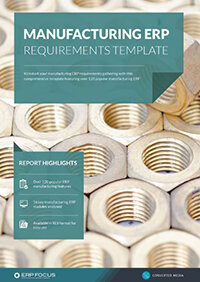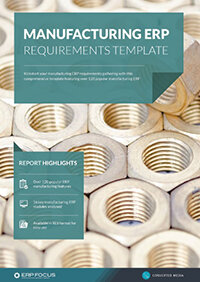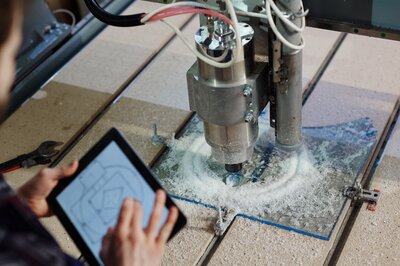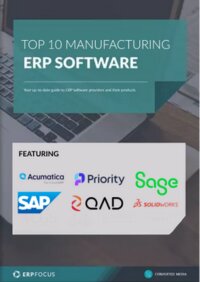What industrial manufacturers should look for in ERP
No matter the size of the plant, it can be difficult for industrial manufacturers to find a one-size-fits-all ERP solution. New technology in industrial manufacturing is a daily occurrence. Given the ever-changing industrial manufacturing environment, how will your ERP keep pace and remain beneficial? To proactively prepare, we’ll discuss some features and functionalities you should look for in an industrial ERP.
Examining the 4 Cs: customers, components, company, competitors
In industrial manufacturing, selling is primarily B2B. Having an ERP that focuses on all 4 Cs (customers, components, company, and competitors) simultaneously is going to be most beneficial. When selecting industrial ERP, take into account the relationships that exist between your company (company), your customers, your suppliers (components), and your competitors and how your system will impact each of these touchpoints.
Company, customers, and components
When a new customer is acquired, or an existing customer has additional needs or requirements, it should trigger a few questions: can your existing supplier cater to these additional needs or is it necessary to find a new supplier? If there were disruptions to the supply, are you confident that you’d be notified and able to react quickly? To proactively prepare for these situations, an industrial ERP should have:
1) Good CRM (manage, maintain, track customer relations).
2) Good SRM (manage, maintain, track supplier relations).
3) An easy-to-use workflow engine – when something changes, it can be seen instantaneously.
4) Capabilities for a customer portal, a supplier portal, and supplier self service.
5) Good visibility of customer and supplier metrics on a dashboard.
Compare the best manufacturing ERP with our free comparison tool
Company and customers
In instances where a customer launches a new product or inputs a substantially large order, other questions to consider will arise: what are the processes to stock up on inventory and plant capacity to fulfil the demand? Do you know your costs well enough to effectively and competitively quote the ask? To proactively prepare for these situations, your industrial manufacturing ERP features should include:
1) Robust, real-time inventory management capable of providing cost of the inventory, value of the inventory, turns, shelf life, SLOB (Slow and obsolete).
2) Plant capacity management that provides a clear idea of the capacity of your plant and allows you to add resources and increase capacity, see your constrained resources, see how many more jobs you can take on without putting in new investment, and consider how to reduce plant capacity and where.
3) Robust financial system that provides visibility on the profitability of customers or shipments. This will also help inform decisions to pull demand and make to stock or make to order, change an order size, or postpone manufacturing to pre-make and stock some sub-assemblies.
4) Integrated quality management system (QMS) that allows for configuring, measuring, recording and printing of incoming, in process, and outgoing quality. This will directly help with passing your first article testing or PPAP.
5) Engineering change management/new product development system to properly version control inventory of components and assemblies, isolate or swap inventory with different revisions, and ensure form fit and function per customer requirements.
Company needs
It’s also necessary to understand the basic ERP needs of your company. You should take into account company stakeholders, corporate structure, and culture. Ensure you consider:
1) Multi company/subsidiary features that address intercompany and cross border transactions, exchange rates, and an multi-company reconciliation needs.
2) Effective, real-time reporting to easily communicate profitability and ROI metrics to stakeholders.
3) Technology stack that easily flows with your existing technology infrastructure.
4) Ease of implementation – this consists of either finding an ERP with a defined implementation methodology or an implementation partner who will do the heavy lifting.
5) Ease of migration to account for any possibility of future acquisitions.
Understanding that the purchase decision and success criterion for an ERP implementation is multi-dimensional is the key to getting started in your search. The long-term rewards of making a good ERP selection will outweigh the extensive upfront research and result in a new phase of growth.
Recap:
1) Good CRM (manage, maintain, track customer relations)
2) Good SRM (manage, maintain, track supplier relations)
3) Easy-to-use workflow engine
4) Capabilities for a Customer Portal, a Supplier Portal, and Supplier Self Service
5) Good visibility of Customer and Supplier metrics on a dashboard
6) Robust, real-time Inventory Management
7) Plant Capacity Management
8) Robust Financial System
9) Integrated Quality Management System (QMS)
10) Engineering Change Management/New Product Development System
11) Multi-company/Subsidiary Feature
12) Effective, real-time reporting
13) Technology stack
14) Ease of implementation
Guest blog by Piyas Bandyopadhyay from Paapri Cloud Technologies.
Free white paper

Manufacturing ERP requirements template
Over 120 critical manufacturing ERP features in one downloadable spreadsheet

Featured white papers
Related articles
-

ERP for make-to-order manufacturing
How can ERP help your make-to-order manufacturing business thrive?
-

Secret KPI: Why Your ERP Implementation Team Matters More Than Software
Learn how Godlan ensures successful ERP implementation for manufacturers with proven strategies &...
-

Shop floor management: 4 ways ERP can improve efficiency
Learn about the shop floor efficiencies that can be realized through the implementation of manufa...




